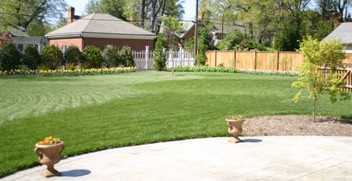
A lush green lawn and healthy plants prosper from watering correctly. Develop an effective watering system to give you the best landscaping.
SUMMER IS THE HARDEST SEASON FOR YOUR LANDSCAPE PLANTS TO SURVIVE! Virginia’s high temperatures and humidity stresses plants. How do you help them make it through the summer, giving you another growing season where your plants improve and not decline? PROPER WATERING is of utmost importance. Automatic irrigation systems are a wonderful tool that saves you time and delivers water efficiently. The problem I see with these systems is the lack of monitoring once the system is turned on for the season. Monitor your system by adjusting the amount of time you water and watering frequency to be adequate for your soil and plants. This adjustment can change on a fairly regular basis. Rainfall and air temperature effects soil moisture. Also, as a landscape grows, plants can start blocking water delivery from the irrigation heads. Heads may need to be adjusted or moved to accommodate this change.
For shrub beds there is an easy test you can perform to check soil moisture. Make a small hole five to six inches deep just outside the root ball. This can be done with a soil probe or trowel. The soil needs to be moist, not wet. If the soil is soupy wet, you are overwatering or the soil is not draining properly. In Richmond, VA where there is heavy clay soils, improper drainage is a common problem. The symptoms (wilting, yellowing leaves and dropping leaves) of over watering and under watering shrubs, trees and groundcovers are the same, so the soil moisture test is the only true way of knowing how much water is needed.
Lawn needs more water than shrub beds. It is important when having an automatic system designed to separate the shrub bed zones from the lawn zones. This will help keep you from overwatering the shrub beds. Lawn needs one inch of water per week. What this means is that you are able to push a four-inch screw driver into the soil at all times. This takes watering on a very regular schedule at a time interval that is appropriate for your site conditions. The symptoms of under watering are dieback (grass dies in patches and is replaced by weeds). Unfortunately, proper watering cannot always eliminate burning. In hot western and southern exposures, fescue can burn creating brown spots in your lawn. Cut your grass at a 3 or 4 inch height to keep it strong enough to fight the hot conditions in these types of areas. Over watering your lawn creates wet spots, rotting and fungus problems. Water your lawn in the early morning, so the warm sun during the day can dry the leaf blades giving fungus less favorable conditions.
Rain gauges are an accessory for automatic irrigation systems. They measure the amount of rain and shuts the system off when the rainfall has been adequate. They are a good tool that helps save water.
Enjoy the summer! Your plants will thrive and grow by giving attention to their watering needs.
|




